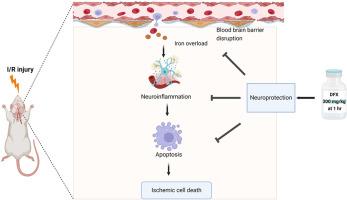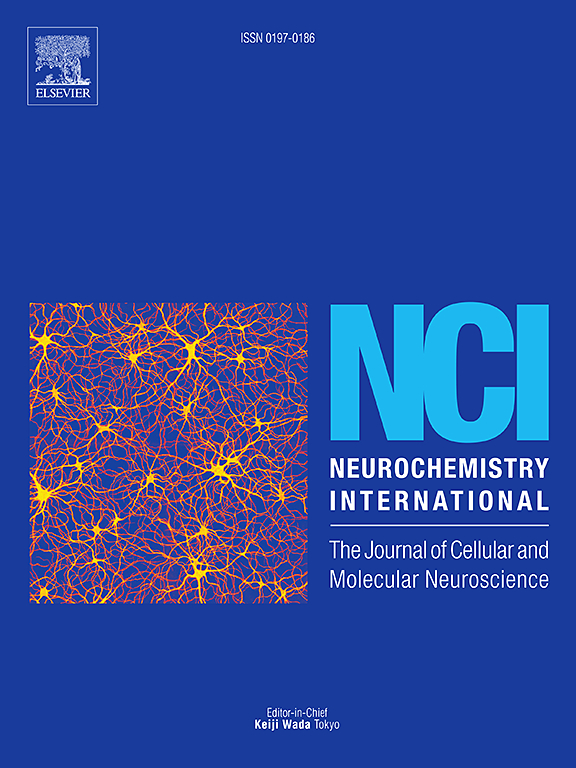去铁胺可预防缺血再灌注损伤早期血脑屏障破坏、神经炎症和细胞凋亡改变。
IF 4
3区 医学
Q2 BIOCHEMISTRY & MOLECULAR BIOLOGY
引用次数: 0
摘要
背景:铁与缺血/再灌注损伤(I/R)脑损伤有关。去铁胺(DFX)是一种铁螯合剂,在I/R动物模型中具有神经保护作用。然而,其潜在机制正在调查中。本研究旨在探讨DFX对血脑屏障破坏、神经炎症和细胞凋亡导致的I/R损伤的影响。方法:采用大脑中动脉闭塞法(MCAO)诱导成年雄性Wistar大鼠脑缺血。大鼠分别在I/R损伤后1、2和3小时腹腔注射100、200和300 mg/kg剂量的载药或DFX。I/R损伤24 h后,通过组织学染色和行为学评价观察DFX的神经保护作用。Evans蓝染色及MMP9表达评价血脑屏障(BBB)完整性。通过免疫组化分析观察DFX的抗炎作用,通过CREB、caspase-3、BDNF和Bcl-2 mRNA表达观察其抗凋亡作用。结果:DFX (300 mg/kg)在I/R损伤1小时可改善脑梗死、神经功能缺损和梁行走评分。组织学上,赫斯特、苏木精和伊红(h&e)和甲氧基紫染色显示DFX治疗大鼠神经元死亡减少。埃文斯蓝染色观察到,它减轻了血脑屏障的破坏。此外,DFX降低了MMP-9的表达,表明减少了血脑屏障破坏和改善炎症变化(CD86和CD206)。抑制cleaved caspase-3 mRNA的表达,提高BDNF和Bcl-2的表达。结论:我们的研究结果表明,DFX通过减少血脑屏障破坏、炎症和细胞凋亡,在I/R损伤早期(1小时)预防I/R脑损伤。DFX可能在急性缺血性脑卒中的治疗中显示出辅助治疗的潜力。本文章由计算机程序翻译,如有差异,请以英文原文为准。

Deferoxamine prevents BBB disruption, neuroinflammation and apoptotic changes in early hours of ischemic reperfusion injury
Background
Iron contributes to brain damage in ischemia/reperfusion injury (I/R). Deferoxamine (DFX), an iron chelator, offers neuroprotective action in I/R animal models. However, its underlying mechanism is under investigation. This study aims to investigate effect of DFX on I/R damage led by BBB disruption, neuroinflammation, and apoptosis.
Methods
In adult male Wistar rats, cerebral ischemia was induced by middle cerebral artery occlusion (MCAO). Rats were treated with vehicle or DFX at 100, 200, and 300 mg/kg doses intraperitoneally (i.p.) at time intervals 1, 2, and 3 h of I/R injury. The neuroprotective effect of DFX was observed using histological staining and behavioural assessment after 24 h of I/R injury. Blood-brain barrier (BBB) integrity was evaluated by Evans blue staining & MMP9 expression. Anti-inflammatory effect of DFX was observed using immunohistochemical analysis whereas, anti-apoptotic effects via mRNA expressions of CREB, caspase-3, BDNF and Bcl-2.
Results
DFX (300 mg/kg) at 1 h of I/R injury ameliorates cerebral infarction, neurological deficits, and beam walk score. Histologically, Hoechst, hematoxylin and eosin (H & E), and cresyl violet stainings showed reduced neuronal death in DFX treated rats. It mitigates BBB disruption as observed with Evans blue staining. Additionally, DFX reduced MMP-9 expression indicative of reduced BBB disruption and improved inflammatory changes (CD86 and CD206). Besides, it inhibits mRNA expression of cleaved caspase-3 and improved expression of BDNF and Bcl-2.
Conclusions
Our findings, demonstrate that DFX prevents I/R brain damage in early hour (1 h) of I/R injury by reducing BBB disruption, inflammation, and apoptosis. DFX may exhibit potential to act as adjuvant in management of acute ischemic stroke.
求助全文
通过发布文献求助,成功后即可免费获取论文全文。
去求助
来源期刊

Neurochemistry international
医学-神经科学
CiteScore
8.40
自引率
2.40%
发文量
128
审稿时长
37 days
期刊介绍:
Neurochemistry International is devoted to the rapid publication of outstanding original articles and timely reviews in neurochemistry. Manuscripts on a broad range of topics will be considered, including molecular and cellular neurochemistry, neuropharmacology and genetic aspects of CNS function, neuroimmunology, metabolism as well as the neurochemistry of neurological and psychiatric disorders of the CNS.
 求助内容:
求助内容: 应助结果提醒方式:
应助结果提醒方式:


